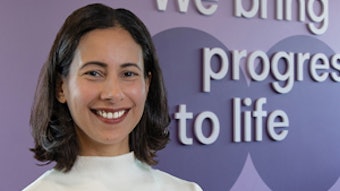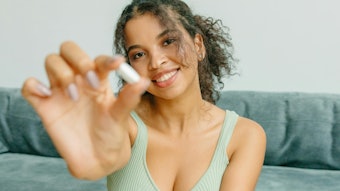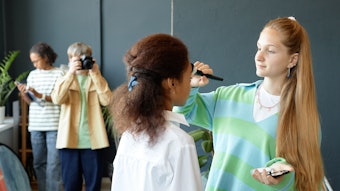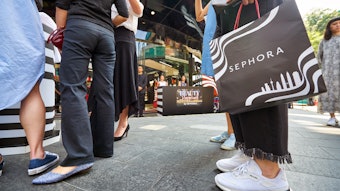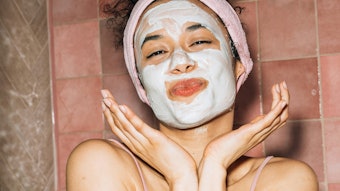While in Brazil for the launch of the Twins fragrance, Gérard Delcour, president of Parfums Azzaro, a Clarins Group brand, noted that Clarins’ revenue in Brazil rose 16.6% in 2008. He forecasts the company’s sales growth to be 30% by the end of 2009.
After the success of Azzaro Pour Homme, which Delcour claims to have been the leading male fragrance in Brazil in 2008, the French company has undertaken a strategy to launch products that will attract younger consumers. According to Delcour, the new releases don’t compete against the brand’s best sellers, but they help bolster the brand. “Although sales [of new releases] add 6–7% to the total, they do a lot in terms of changing public perception—demonstrating that Azzaro is not only a classic, but a brand constantly up-to-date.”
In 2009, the Clarins Group intends to gain a position in the Brazilian fragrance ranking, jumping from fourth to third—beyond top sellers Carolina Herrera and Christian Dior. Who will be surpassed? Delcour prefers not to say.
“Brazil is the one of the [top markets] for perfumes and cosmetics expansion in the world,” Delcour said. According to his projections, Brazil, Russia, India and China—the BRIC nations—will account for 60% of global growth within the next five years. Euromonitor International also expects BRIC nations to be the biggest contributors to absolute growth.
Nivea Grows 17.4% in Brazil
Nicolas Fischer, president of Nivea Brazil, had good news to announce at brand owner Beiersdorf’s global meeting—the brand’s Brazilian efforts resulted in a 17.4% sales increase for the first quarter of 2009, the brand’s largest gain. The company’s worldwide revenue dropped 0.5% in the same period. In Europe (excluding Germany, which posted an increase of 7.2%) sales fell 7.8%, and North American sales fell 5.4%. And—except for Russia, which retracted 4%—developing markets posted positive numbers. Sales in Mexico grew 11.7%, while Argentina grew 12.8% and China 12.2%.
If Nivea maintains this pace in Brazil for the remainder of 2009, it anticipates achieving its 2010 sales growth forecast a year early. “When I took [over as president] in 2005, my aim was to double the size of the division in five years,” said Fischer. “But with the growth achieved in the last three years (16% in 2006, 22% in 2007 and another 22% in 2008), I believe my goal will be reached before that.”
According to Fischer, there are a number of reasons for the performance of the Brazilian division, the first being the country’s economic scenario. “Brazil has never been so prepared to face a financial crisis,” he said. “More than half of its GDP comes from the domestic market, which minimizes the influence of the downturn in business.” Consumer behavior also bolstered sales. “Many people stopped buying cars or properties. They could have saved the money, as it happens in many countries, but Brazilians’ expenses were transferred to consumer goods.”
At least through December 2009, Nivea’s strategy will be to maintain its schedule of new launches, which account for one-third of total sales, and to target the male market. “These products have great growth potential. Brazilian men still have the habit to shave in the shower, using just soap,” said Fischer.
Supermarket Chain Launches Cosmetic Line
A branch of the Carrefour Group, supermarket chain Dia, launched an exclusive cosmetic brand, which will be available in more than 100 of its stores. Bio Pure is a line of 22 products for hair, skin and body care. The brand claims its prices are 15% lower than those of its primary competitors.
The brand expansion strategy includes an outsourcing manufacturing partnership with Lifar Laboratory. The brand also integrates the Dia’s guaranteed satisfaction program. Customers not happy with a purchase have four days to return products to the store.
More Brazilian Men are Opting for Hair Removal
Research conducted by Millward Brown Brazil showed that 14% of Brazilian men are opting for body hair removal. The study found that approximately 23% of men used some kind of hair removal method on their chests, 22% on their bikini lines, 48% on their underarms and 1% on their backs. Forty-nine percent of the interviewees shave once or twice a week, while 33% shave everyday or every two days.
According to Euromonitor International data, sales of hair removal products—including creams, waxes, blades, and pre- and after-shaving items—increased 30.2% in 2008, reaching a value of $140 million, outstripping the global average growth of 8.32%. Nevertheless, Brazil still holds eighth-place hair removal sales ranking—behind the U.S., Japan, Canada and a number of European countries.
According to João Carlos Basilio, president of ABIHPEC (Brazilian Association of the Cosmetic, Toiletry & Fragrance Industry), the primary reason that the country—famous for its “Brazilian wax”—does not post larger sales numbers in the product segment is the popularity of hair removal service providers. “The prices charged in beauty salons are lower than in other countries, which make their services very popular,” said Basilio. “Many of these businesses also manufacture their own products, and that doesn’t help the industry’s performance.”
Project Stimulates Development of Bio-materials in the Amazon
The northern Brazilian states of Pará, Maranhão, Amazonas, Acre and Tocantins have launched RedeBio, a network for research and development of bio-materials. With an inaugural investment of $3.6 million, the initiative aims to articulate partnerships between research institutes, manufacturing companies and local communities in order to transform natural resources into value-added products.
The launch will happen in two stages. The first, originally announced in May 2009, involves the formation of a group of researchers that will present projects involving Amazon raw materials such as andiroba, copaiba, the Brazil nut and babassu. The next stage, to be launched in late 2009, will deal with requirements for the participation of companies in order to build a bridge between the industry and research institutes.
Cosmetics Surpass Sales of Medicines in Drugstores and Pharmacies
The Brazilian Association for Pharmacy and Drugstore Chains (ABRAFARMA) announced a 28.65% rise in drugstore and pharmacy beauty product sales in the first quarter of 2009—a value of $400 million, and accounting for approximately 27% of the $1.4 billion value of sales across channels. In the same period, medicine sales in drugstore and pharmacy channels grew 21.49%.
Fernanda Bonifacio is a Brazilian journalist who focuses on the beauty industry, and has been published in the U.S. and Europe. During 2002–2008, she represented ABIHPEC and its member companies globally.

